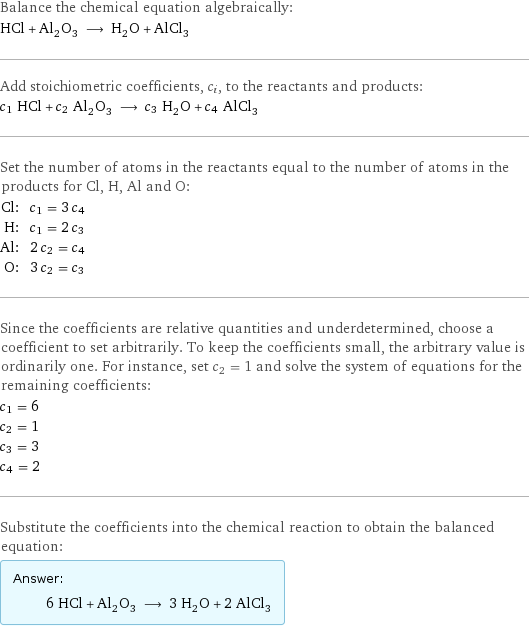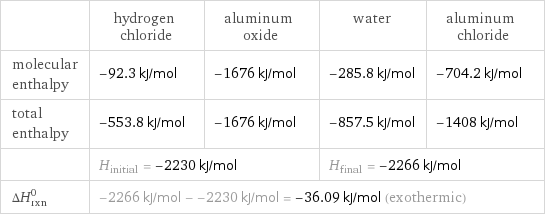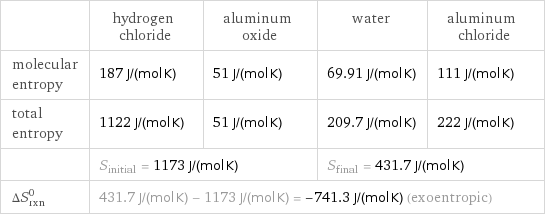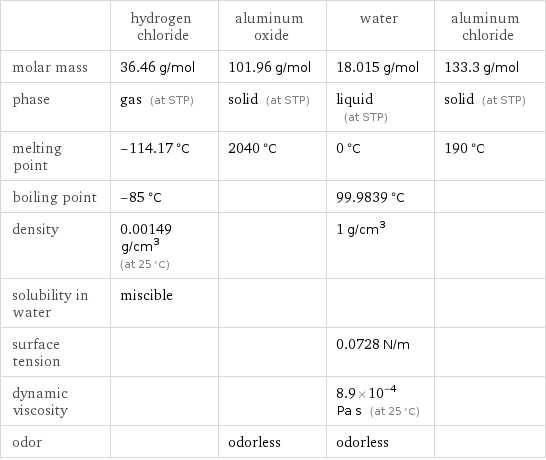Input interpretation

HCl (hydrogen chloride) + Al_2O_3 (aluminum oxide) ⟶ H_2O (water) + AlCl_3 (aluminum chloride)
Balanced equation

Balance the chemical equation algebraically: HCl + Al_2O_3 ⟶ H_2O + AlCl_3 Add stoichiometric coefficients, c_i, to the reactants and products: c_1 HCl + c_2 Al_2O_3 ⟶ c_3 H_2O + c_4 AlCl_3 Set the number of atoms in the reactants equal to the number of atoms in the products for Cl, H, Al and O: Cl: | c_1 = 3 c_4 H: | c_1 = 2 c_3 Al: | 2 c_2 = c_4 O: | 3 c_2 = c_3 Since the coefficients are relative quantities and underdetermined, choose a coefficient to set arbitrarily. To keep the coefficients small, the arbitrary value is ordinarily one. For instance, set c_2 = 1 and solve the system of equations for the remaining coefficients: c_1 = 6 c_2 = 1 c_3 = 3 c_4 = 2 Substitute the coefficients into the chemical reaction to obtain the balanced equation: Answer: | | 6 HCl + Al_2O_3 ⟶ 3 H_2O + 2 AlCl_3
Structures

+ ⟶ +
Names

hydrogen chloride + aluminum oxide ⟶ water + aluminum chloride
Reaction thermodynamics
Enthalpy

| hydrogen chloride | aluminum oxide | water | aluminum chloride molecular enthalpy | -92.3 kJ/mol | -1676 kJ/mol | -285.8 kJ/mol | -704.2 kJ/mol total enthalpy | -553.8 kJ/mol | -1676 kJ/mol | -857.5 kJ/mol | -1408 kJ/mol | H_initial = -2230 kJ/mol | | H_final = -2266 kJ/mol | ΔH_rxn^0 | -2266 kJ/mol - -2230 kJ/mol = -36.09 kJ/mol (exothermic) | | |
Gibbs free energy

| hydrogen chloride | aluminum oxide | water | aluminum chloride molecular free energy | -95.3 kJ/mol | -1582 kJ/mol | -237.1 kJ/mol | -628.8 kJ/mol total free energy | -571.8 kJ/mol | -1582 kJ/mol | -711.3 kJ/mol | -1258 kJ/mol | G_initial = -2154 kJ/mol | | G_final = -1969 kJ/mol | ΔG_rxn^0 | -1969 kJ/mol - -2154 kJ/mol = 184.9 kJ/mol (endergonic) | | |
Entropy

| hydrogen chloride | aluminum oxide | water | aluminum chloride molecular entropy | 187 J/(mol K) | 51 J/(mol K) | 69.91 J/(mol K) | 111 J/(mol K) total entropy | 1122 J/(mol K) | 51 J/(mol K) | 209.7 J/(mol K) | 222 J/(mol K) | S_initial = 1173 J/(mol K) | | S_final = 431.7 J/(mol K) | ΔS_rxn^0 | 431.7 J/(mol K) - 1173 J/(mol K) = -741.3 J/(mol K) (exoentropic) | | |
Equilibrium constant
![Construct the equilibrium constant, K, expression for: HCl + Al_2O_3 ⟶ H_2O + AlCl_3 Plan: • Balance the chemical equation. • Determine the stoichiometric numbers. • Assemble the activity expression for each chemical species. • Use the activity expressions to build the equilibrium constant expression. Write the balanced chemical equation: 6 HCl + Al_2O_3 ⟶ 3 H_2O + 2 AlCl_3 Assign stoichiometric numbers, ν_i, using the stoichiometric coefficients, c_i, from the balanced chemical equation in the following manner: ν_i = -c_i for reactants and ν_i = c_i for products: chemical species | c_i | ν_i HCl | 6 | -6 Al_2O_3 | 1 | -1 H_2O | 3 | 3 AlCl_3 | 2 | 2 Assemble the activity expressions accounting for the state of matter and ν_i: chemical species | c_i | ν_i | activity expression HCl | 6 | -6 | ([HCl])^(-6) Al_2O_3 | 1 | -1 | ([Al2O3])^(-1) H_2O | 3 | 3 | ([H2O])^3 AlCl_3 | 2 | 2 | ([AlCl3])^2 The equilibrium constant symbol in the concentration basis is: K_c Mulitply the activity expressions to arrive at the K_c expression: Answer: | | K_c = ([HCl])^(-6) ([Al2O3])^(-1) ([H2O])^3 ([AlCl3])^2 = (([H2O])^3 ([AlCl3])^2)/(([HCl])^6 [Al2O3])](../image_source/85555af4159f2af20d13733e94676ffd.png)
Construct the equilibrium constant, K, expression for: HCl + Al_2O_3 ⟶ H_2O + AlCl_3 Plan: • Balance the chemical equation. • Determine the stoichiometric numbers. • Assemble the activity expression for each chemical species. • Use the activity expressions to build the equilibrium constant expression. Write the balanced chemical equation: 6 HCl + Al_2O_3 ⟶ 3 H_2O + 2 AlCl_3 Assign stoichiometric numbers, ν_i, using the stoichiometric coefficients, c_i, from the balanced chemical equation in the following manner: ν_i = -c_i for reactants and ν_i = c_i for products: chemical species | c_i | ν_i HCl | 6 | -6 Al_2O_3 | 1 | -1 H_2O | 3 | 3 AlCl_3 | 2 | 2 Assemble the activity expressions accounting for the state of matter and ν_i: chemical species | c_i | ν_i | activity expression HCl | 6 | -6 | ([HCl])^(-6) Al_2O_3 | 1 | -1 | ([Al2O3])^(-1) H_2O | 3 | 3 | ([H2O])^3 AlCl_3 | 2 | 2 | ([AlCl3])^2 The equilibrium constant symbol in the concentration basis is: K_c Mulitply the activity expressions to arrive at the K_c expression: Answer: | | K_c = ([HCl])^(-6) ([Al2O3])^(-1) ([H2O])^3 ([AlCl3])^2 = (([H2O])^3 ([AlCl3])^2)/(([HCl])^6 [Al2O3])
Rate of reaction
![Construct the rate of reaction expression for: HCl + Al_2O_3 ⟶ H_2O + AlCl_3 Plan: • Balance the chemical equation. • Determine the stoichiometric numbers. • Assemble the rate term for each chemical species. • Write the rate of reaction expression. Write the balanced chemical equation: 6 HCl + Al_2O_3 ⟶ 3 H_2O + 2 AlCl_3 Assign stoichiometric numbers, ν_i, using the stoichiometric coefficients, c_i, from the balanced chemical equation in the following manner: ν_i = -c_i for reactants and ν_i = c_i for products: chemical species | c_i | ν_i HCl | 6 | -6 Al_2O_3 | 1 | -1 H_2O | 3 | 3 AlCl_3 | 2 | 2 The rate term for each chemical species, B_i, is 1/ν_i(Δ[B_i])/(Δt) where [B_i] is the amount concentration and t is time: chemical species | c_i | ν_i | rate term HCl | 6 | -6 | -1/6 (Δ[HCl])/(Δt) Al_2O_3 | 1 | -1 | -(Δ[Al2O3])/(Δt) H_2O | 3 | 3 | 1/3 (Δ[H2O])/(Δt) AlCl_3 | 2 | 2 | 1/2 (Δ[AlCl3])/(Δt) (for infinitesimal rate of change, replace Δ with d) Set the rate terms equal to each other to arrive at the rate expression: Answer: | | rate = -1/6 (Δ[HCl])/(Δt) = -(Δ[Al2O3])/(Δt) = 1/3 (Δ[H2O])/(Δt) = 1/2 (Δ[AlCl3])/(Δt) (assuming constant volume and no accumulation of intermediates or side products)](../image_source/f4f2850f5956c0932446e17d25f18fb0.png)
Construct the rate of reaction expression for: HCl + Al_2O_3 ⟶ H_2O + AlCl_3 Plan: • Balance the chemical equation. • Determine the stoichiometric numbers. • Assemble the rate term for each chemical species. • Write the rate of reaction expression. Write the balanced chemical equation: 6 HCl + Al_2O_3 ⟶ 3 H_2O + 2 AlCl_3 Assign stoichiometric numbers, ν_i, using the stoichiometric coefficients, c_i, from the balanced chemical equation in the following manner: ν_i = -c_i for reactants and ν_i = c_i for products: chemical species | c_i | ν_i HCl | 6 | -6 Al_2O_3 | 1 | -1 H_2O | 3 | 3 AlCl_3 | 2 | 2 The rate term for each chemical species, B_i, is 1/ν_i(Δ[B_i])/(Δt) where [B_i] is the amount concentration and t is time: chemical species | c_i | ν_i | rate term HCl | 6 | -6 | -1/6 (Δ[HCl])/(Δt) Al_2O_3 | 1 | -1 | -(Δ[Al2O3])/(Δt) H_2O | 3 | 3 | 1/3 (Δ[H2O])/(Δt) AlCl_3 | 2 | 2 | 1/2 (Δ[AlCl3])/(Δt) (for infinitesimal rate of change, replace Δ with d) Set the rate terms equal to each other to arrive at the rate expression: Answer: | | rate = -1/6 (Δ[HCl])/(Δt) = -(Δ[Al2O3])/(Δt) = 1/3 (Δ[H2O])/(Δt) = 1/2 (Δ[AlCl3])/(Δt) (assuming constant volume and no accumulation of intermediates or side products)
Chemical names and formulas

| hydrogen chloride | aluminum oxide | water | aluminum chloride formula | HCl | Al_2O_3 | H_2O | AlCl_3 Hill formula | ClH | Al_2O_3 | H_2O | AlCl_3 name | hydrogen chloride | aluminum oxide | water | aluminum chloride IUPAC name | hydrogen chloride | dialuminum;oxygen(2-) | water | trichloroalumane
Substance properties

| hydrogen chloride | aluminum oxide | water | aluminum chloride molar mass | 36.46 g/mol | 101.96 g/mol | 18.015 g/mol | 133.3 g/mol phase | gas (at STP) | solid (at STP) | liquid (at STP) | solid (at STP) melting point | -114.17 °C | 2040 °C | 0 °C | 190 °C boiling point | -85 °C | | 99.9839 °C | density | 0.00149 g/cm^3 (at 25 °C) | | 1 g/cm^3 | solubility in water | miscible | | | surface tension | | | 0.0728 N/m | dynamic viscosity | | | 8.9×10^-4 Pa s (at 25 °C) | odor | | odorless | odorless |
Units
